英国的宗教信仰 英文版
- 格式:ppt
- 大小:1019.50 KB
- 文档页数:11
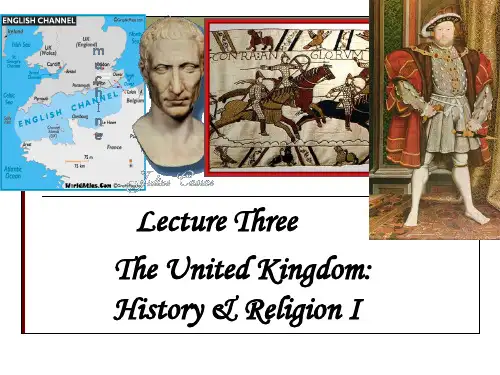
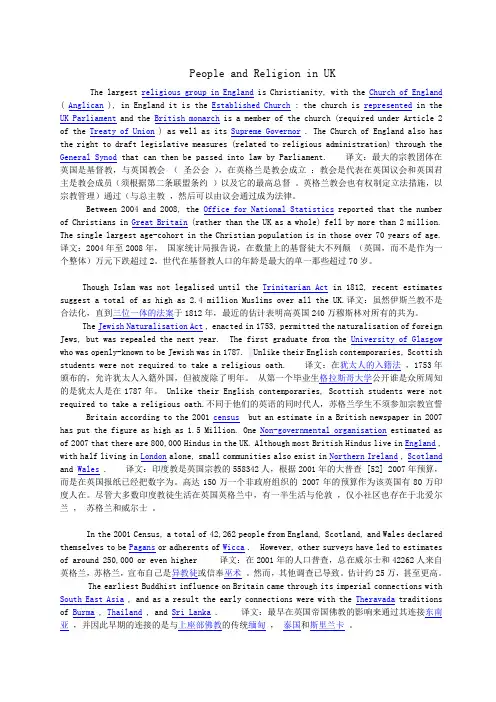
People and Religion in UKThe largest religious group in England is Christianity, with the Church of England ( Anglican ), in England it is the Established Church : the church is represented in the UK Parliament and the British monarch is a member of the church (required under Article 2of the Treaty of Union ) as well as its Supreme Governor . The Church of England also has the right to draft legislative measures (related to religious administration) through the General Synod that can then be passed into law by Parliament. 译文:最大的宗教团体在英国是基督教,与英国教会(圣公会),在英格兰是教会成立:教会是代表在英国议会和英国君主是教会成员(须根据第二条联盟条约)以及它的最高总督。
英格兰教会也有权制定立法措施,以宗教管理)通过(与总主教,然后可以由议会通过成为法律。
Between 2004 and 2008, the Office for National Statistics reported that the numberof Christians in Great Britain (rather than the UK as a whole) fell by more than 2 million. The single largest age-cohort in the Christian population is in those over 70 years of age. 译文:2004年至2008年,国家统计局报告说,在数量上的基督徒大不列颠(英国,而不是作为一个整体)万元下跌超过2。

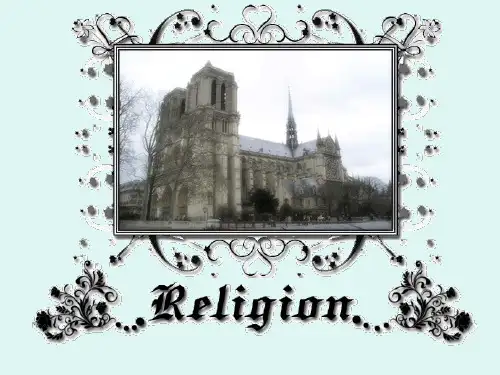
![【英语国家概况教学】religious英国宗教[1]3](https://uimg.taocdn.com/5e704503bed5b9f3f90f1c68.webp)
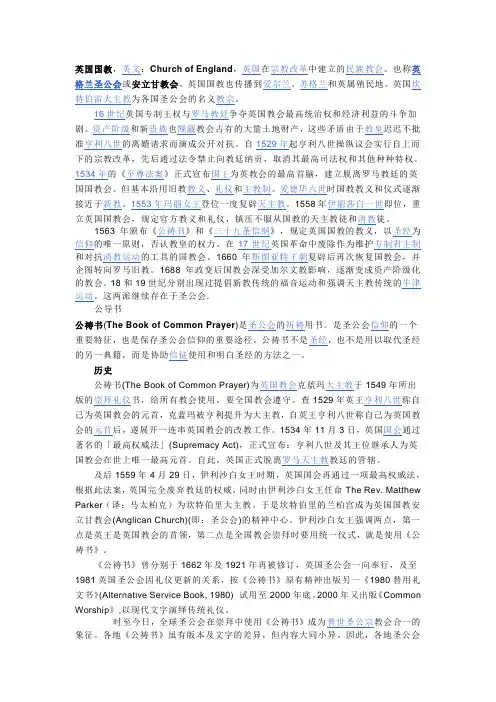
英国国教,英文:Church of England,英国在宗教改革中建立的民族教会。
也称英格兰圣公会或安立甘教会。
英国国教也传播到爱尔兰、苏格兰和英属殖民地。
英国坎特伯雷大主教为各国圣公会的名义教宗。
16世纪英国专制王权与罗马教廷争夺英国教会最高统治权和经济利益的斗争加剧。
资产阶级和新贵族也觊觎教会占有的大量土地财产,这些矛盾由于教皇迟迟不批准亨利八世的离婚请求而演成公开对抗。
自1529年起亨利八世操纵议会实行自上而下的宗教改革,先后通过法令禁止向教廷纳贡,取消其最高司法权和其他种种特权。
1534年的《至尊法案》正式宣布国王为英教会的最高首脑,建立脱离罗马教廷的英国国教会。
但基本沿用旧教教义、礼仪和主教制。
爱德华六世时国教教义和仪式逐渐接近于新教。
1553年玛丽女王登位一度复辟天主教。
1558年伊丽莎白一世即位,重立英国国教会,规定官方教义和礼仪,镇压不服从国教的天主教徒和清教徒。
1563年颁布《公祷书》和《三十九条信纲》,规定英国国教的教义,以圣经为信仰的唯一原则,否认教皇的权力。
在17世纪英国革命中废除作为维护专制君主制和对抗清教运动的工具的国教会。
1660年斯图亚特王朝复辟后再次恢复国教会,并企图转向罗马旧教。
1688年政变后国教会深受加尔文教影响,逐渐变成资产阶级化的教会。
18和19世纪分别出现过提倡新教传统的福音运动和强调天主教传统的牛津运动。
这两派继续存在于圣公会.公导书公祷书(The Book of Common Prayer)是圣公会的祈祷用书。
是圣公会信仰的一个重要特征,也是保存圣公会信仰的重要途径。
公祷书不是圣经,也不是用以取代圣经的另一典籍,而是协助信徒使用和明白圣经的方法之一。
历史公祷书(The Book of Common Prayer)为英国教会克蓝玛大主教于1549年所出版的崇拜礼仪书,给所有教会使用,要全国教会遵守。
查1529年英王亨利八世称自己为英国教会的元首,克蓝玛被亨利提升为大主教,自英王亨利八世称自己为英国教会的元首后,遂展开一连串英国教会的改教工作。
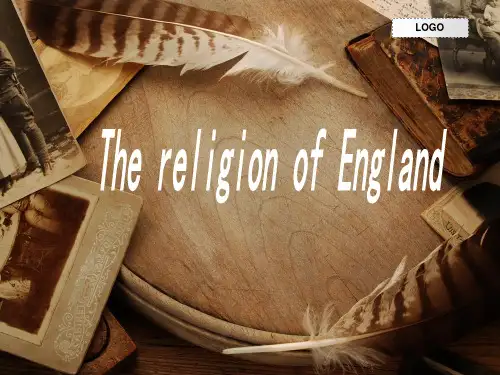
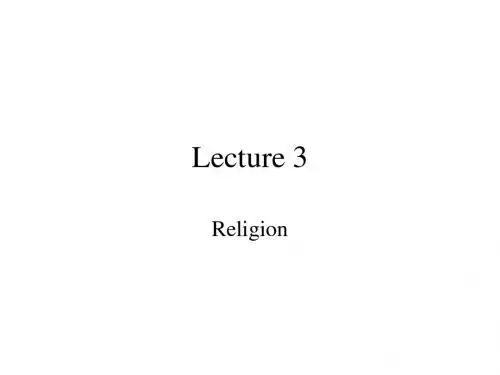
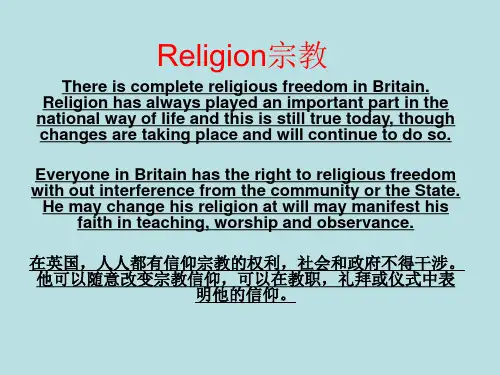
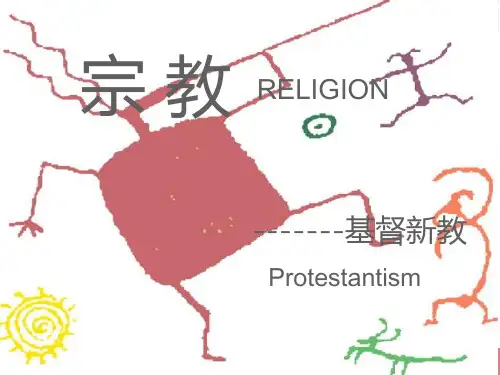
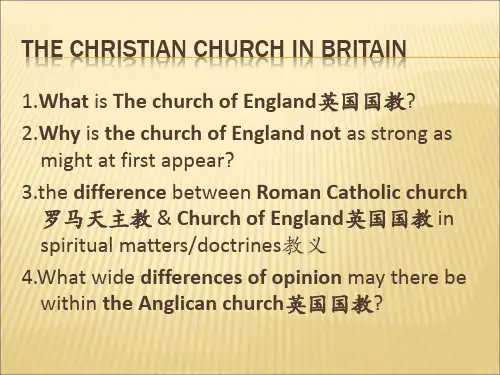
British Religion and BeliefsI.Christianity1.The British are Christians—in name at least.2.Jesus Christ (also called Jesus of Galilee [ ♈✌●☜●♓]加利利,巴勒斯坦北部地区 or Jesus of Nazareth[ ⏹✌☜❒♓]巴勒斯坦地区北部古城,拿撒勒)was a Jew who lived in Palestine 2,000 years ago and is accepted by Christians as the son of God. He wasmiraculous conceived by a virgin called Mary. His teachings conflicted with orthodox Jewish laws and doctrines and at 33 he was executed by crucifixion. It believed that he rose from dead, ascended into Heaven, and sent his spirit into the hearts of his twelve apostles to inspire them to spread his teaching.3.Christ’s teaching was based on love: love of God and of our neighbor (our fellow-menregardless of race). Love, humility, repentance and prayer lead to everlasting happiness inHeaven.4.The Bible (the holy book of Christianity) consists of the Old Testament (39 books) and the NewTestament. (27 books) The Old Testament contains the Jewish writings before the coming of Christ and the New Testament contains four accounts (“gospels”福音书) of the life of Christ followed by the writings of the early Christians, of whom St. Paul was the greatest. Christian doctrine as developed by St. Paul and the early Church states that Jesus Christ was in fact God in the form of a man, and that God (Holy Father), Jesus (Holy Son) and the Holy Spirit are three aspects of the same God (the Trinity). Jesus took upon himself the punishment of the sins of men and his death saves us from sin and proves that God love us.II.Christianity in Britain1.The Church of England, or the Anglican Church is one of the many Protestant sects thatbroke away from the early Roman Catholic Church during the Religious Reformation. It is an “established” Church, which means that it represents the official state religion. Itstemporal (non-priestly) head is the Crown, and 26 of its highest bishops and Archbishops in Canterbury and York (after their retirement) sit in the House of Lords. Roman Catholics recognize (admit) the supreme holy authority of the Pope in Rome and of the church or priesthood in general, but the Anglican Church relies more on the Bible. Concerning the Holy Communion, 圣餐礼Roman Catholics believe that the bread and wine actuallybecome the body and blood of Christ, whereas most Anglicans think they are merelyrepresentations. (Roman Catholics do not admit the validity of other churches.)2.Scotland has its own established Church, the Church of Scotland (CalvinisticPresbyterianism[ ☐❒♏♌♓♦♓☜❒♓☜⏹]基督教长老会).3.The Church of England is only a minority. There are several million Roman Catholics inBritain, and more members of the free or nonconformist (不信奉英国国教的)churches including the Presbyterian organizations, the Methodist Church(卫理公会,循道宗), the Congregational Churches, 公理会and the Baptist churches. 浸信会,浸礼教4.Some nonconformist Churches are nominated as “Puritanism” by the Anglican Church,such as the Methodist, the Presbyterian and especially the “Quakers”. The Puritans were originally an extreme Protestant sect. They determined to “purify” the Anglican Church the corruption and ceremonial pomp inherited from Roman Catholicism. The Puritans werecharacterized by stern simplicity and strict morality. (They are often condemned as“kill-joys.”)III.Other Beliefs1.The Christian Scientists believe in faith-healing, i.e., healing the sick by faith throughprayer.2.The Seventh-Day Adventists基督复临安息日会and the Jehovah’s Witnesses 耶和华见证会believe in an imminent “second coming” of Christ to earth when the forces of evil will be finally defeated.tter-Day Saints (or Mormons)后期圣徒(指美国基督教新教摩门教徒) had their ownreligious system and scriptures. And all these three 4 sects originated in 19th centuryAmerica.4.Spiritualists(唯灵论者,招魂术士,招魂灵派)claim to be able to summon the spirits of thedead and comfort the sad the bereaved (丧失亲属的人).5. A large proportion of people in Britain are not really interested in religion at all. Duringthe 19th century religion (Christianity) was very popular; during the 20th century it has seriously declined, and today only a minority go to any kind of church regularly. Most the large majority who do not go to church still believe in God and Heaven in a confused sort of way. They like to get married in church and have their children christened in church and they like to have a Christian funeral when they die.6.Vague notions of belief: It is unlucky to walk under a ladder, or to spill salt, or break amirror, or to have anything to do with number 13; a horseshoe brings good luck, andpeople “touch wood” to prevent the return of a past misfortune. There are still manystrange superstitious country remedies against sickness, and many people believe infortune-telling.plementary material:1.Christ was not originally a name but a title derived from the Greek word christ os, whichtranslates the Hebrew term meshiah (Messiah), meaning “the anointed one.”涂油神圣化的, 基督, 救世主Jesus' followers believed him to be the anointed son of King David, whom some Jews expected to restore the fortunes of Israel.According to Mark 6:3, Jesus also became a carpenter following his legal father Joseph.2.Jesus was born in the time of Herod ([ ♒♏❒☜♎]希律王)who was a Jewish king and whowas loyal to the Roman Empire. When Herod died shortly after Jesus' birth, his kingdom was divided into five parts. In the New Testament, Antipas (Herod Antipas is son of Herod.) is somewhat confusingly called Herod, as in Luke 23:6–12; apparently the sons of Herod took his name, just as the successors of Julius Caesar were commonly called Caesar.On a day-to-day basis Jerusalem was governed by the high priest. Assisted by a council, he had the difficult task of mediating between the remote Roman prefect (supported by a small army of 3,000 men) and the local populace, which was hostile toward pagans and wanted to be free of foreigninterference.Thus, at the time of Jesus' public career, Galilee was governed by the tetrarch (小领主, 一省四个分区之一)Antipas, who was sovereign within his own domain, provided that he remained loyal to Rome and maintained peace and stability within his borders. Judaea(including Jerusalem) was nominally governed by Pilate, (Pontius Pilate彼拉多钉死耶稣的古代罗马的犹太总督) but the actual daily rule of Jerusalem was in the hands of Caiaphas([♊♋✋☜♐✌♦]该亚法,主审耶稣的犹太人大祭司) and his council.3.Gospel: any of four biblical narratives covering the life and death of Jesus Christ. Written,according to tradition, respectively by Matthew, Mark, Luke, and John (the four evangelists), they are placed at the beginning of the New Testament and make up about half the total text.The word gospel is derived from the Anglo-Saxon term god-spell, meaning “good story,” a rendering of the Latin and the Greek (“good news” or “good telling.” )Since the late 18thcentury the first three have been called the Synoptic Gospels, 对观福音书because the texts, set side by side, show a similar treatment of the life and death of Jesus Christ.4.Presbyterianism: one of the major representative groups of classical Protestantism that arose inthe 16th-century Reformation. Generally speaking, the modern Presbyterian churches trace their origins to the Calvinist churches of the British Isles, the Continental counterparts of which came to be known by the more inclusive designation Reformed. The term Presbyterian denotesa collegiate type of church government by pastors and lay leaders called elders, or presbyters.Strictly speaking, all Presbyterian churches are a part of the Reformed, or Calvinist, tradition, although not all Reformed churches are Presbyterian in their form of government.5.The first Christian church in Scotland was founded about 400 by St. Ninian. In the 6th century,Irish missionaries included St. Columba, who settled at Iona about 563.6.Methodism: Methodism is marked by an acceptance of the doctrines of historical Christianity;by an emphasis on doctrines that indicate the power of the Holy Spirit to confirm the faith of believers and to transform their personal lives; by an insistence that the heart of religion lies in a personal relationship with God; by simplicity of worship; by the partnership ofordained ministers and laity in the worship and administration of the church; by a concern for the underprivileged and the improvement of social conditions; and (at least in its British form) by the formation of small groups for mutual encouragement and edification.All Methodist churches accept the Scriptures as the supreme guide to faith and practice.Most welcome the findings of modern biblical scholarship, though the fundamentalist groups among them do not. The churches follow the historical creeds and believe that they are part of the tradition of the Protestant Reformation. They emphasize the teaching of Christian perfection, interpreted as “perfect love,” which is associated with John Wesley, who held that everyChristian should aspire to such perfection with the help of the Holy Spirit.Methodist churches affirm infant baptism. They also regularly receive the sacrament of the Lord's Supper, in which they believe Christ to be truly present, though they have no precise definition of the manner of his presence. They believe that they are integral parts of the one, holy, catholic, and apostolic church and that their ministers are true ministers of Word and sacrament in the church of God.7.Congregationalism: Throughout their history, Congregationalists have shared the beliefs andpractices of the more liberal mainline Evangelical Protestant churches of the English-speaking world. The English historian Bernard Manning once described their position as decentralized Calvinism, in contrast to the centralized Calvinism of Presbyterians. That description contains much truth about their doctrines and outlook through the early 19th century, but itunderestimates the Congregational emphasis on the free movement of the Spirit, which links the Congregationalists with the Quakers and partly explains their reluctance to give binding authority to creedal statements. They have not been slow to produce declarations of faith,however. In addition to the Savoy Declaration, the Cambridge Platform, and the Kansas City Creed, lengthy statements have also been made both by the United Church of Christ and by the English Congregationalists. No great authority is claimed for any of these, and in recentgenerations most Congregationalists have regarded the primitive conf ession, “Jesus is Lord,” asa sufficient basis for membership.Similarly, Congregationalists have always stressed the importance of freedom. Even in the days of Cromwell, they were tolerant by the standards of the time. They contributed greatly in the 18th century to the establishment of the rights of minorities in England through the activities of the Protestant Dissenting deputies, who had the right of direct access to the monarch. Both in England and in America, the long-faced and repressive Puritan of tradition owes as much to the caricatures of opponents as to actual fact.8.Quaker: byname of Friend,member of a Christian group (the Society of Friends, or Friendschurch) that stresses the guidance of the Holy Spirit, that rejects outward rites and an ordained ministry, and that has a long tradition of actively working for peace and opposing war. George Fox, founder of the society in England, recorded that in 1650 “Justic e Bennet of Derby first called us Quakers because we bid them tremble at the word of God.” It is likely that the name, originally derisive, was also used because many early Friends, like other religious enthusiasts, themselves trembled in their religious meetings and showed other physical manifestations of religious emotion. Despite early derisive use, Friends used the term of themselves in suchphrases as “the people of God in scorn called Quakers.” No embarrassment is caused by using the term to or of Friends today.Friends (Religious Society of Friends): religious body originating in England in the middle of the 17th cent. under George Fox. The members are commonly called Quakers,originally a term of derision.Claiming that no theologically trained priest or outward rite is needed to establish communion between the soul and its God, Fox taught that everyone could receive whatever understanding and guidance in divine truth they might need from the "inward light," or "inner light," supplied in their own heart by the Holy Spirit. Many of his early converts were from among groups of separatists. Calling themselves Children of Light, Friends in the Truth, and Friends, they eventually agreed upon the name Religious Society of Friends.The Friends regarded the sacraments of the church as nonessential to Christian life. They refused to attend worship in the established church and to pay tithes. They also resisted the requirement to take oaths and opposed war, refusing to bear arms. Believing in the equality of all men and women, Friends would not remove their hats before their alleged superiors.Consequently, they were subject to persecution until the passage of the Toleration Act of 1689.Yet the Society of Friends is grounded in the experience of God, out of which philanthropic activities may flow. There have always been Friends whose concerns went well beyond what meetings were willing to adopt. Most Friends were not abolitionists before the American Civil War; they probably did not approve of the Underground Railroad nor share the early feminist views of Lucretia Mott and Susan B. Anthony. (Most of the early suffragistleaders in America were Quakers.) The two American presidents of Quaker background were both Republicans: Herbert Hoover and Richard M. Nixon.Bibliography朱永涛.英美文化基础教程.北京:外语教学与研究出版社,1991."Friends, Society of." Encyclopædia Britannica. Encyclopædia Britannica 2007 Deluxe Edition.Chicago: Encyclopædia Britannica, 2010."Methodism." Encyclopædia Britannica. Encyclopædia Britannica 2007 Deluxe Edition. Chicago: Encyclopædia Britannica, 2010."Presbyterian churches." Encyclopædia Britannica. Encyclopædia Britannica 2007 Deluxe Edition.Chicago: Encyclopædia Britannica, 2010."Quaker." Encyclopædia Britannica. Encyclopædia Britannica 2007 Deluxe Edition. Chicago: Encyclopædia Britannica, 2010."Roman Catholicism, history of." Encyclopædia Britannica. Encyclopædia Britannica 2007 Deluxe Edition. Chicago: Encyclopædia Britannica, 2010."Scotland, Church of." Encyclopædia Britannica. Encyclopædia Britannica 2007 Deluxe Edition. Chicago: Encyclopædia Britannica, 2010.。